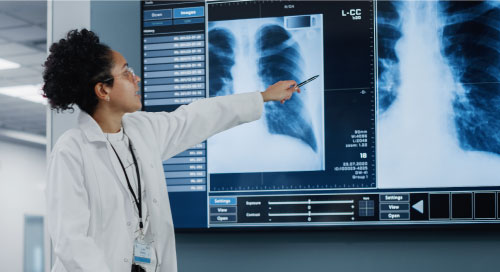Fill form to unlock content
Error - something went wrong!
Your content is just a step away. Please submit below.
Thank you!
AI in Radiology Transforms Cancer Diagnostics

Radiologists spend an inordinate amount of time looking at scans to diagnose conditions, but pioneering solutions are ushering in a new frontier in cancer diagnostic imaging. AI in radiology is emerging at a particularly critical time as health systems face a shortage of radiologists, leading to higher workloads that increase the risk of errors.
The growing volume of scans that doctors must interpret only compounds these challenges. One study demonstrates the risks this shortfall poses as scans grow in volume: When doctors have 50% less time to read radiology exams, the error rate goes up 16%.
Siemens Healthineers, a leading innovator in the healthcare tech industry, developed its AI-Rad Companion platform to increase diagnostic accuracy and reduce operational burdens for radiologists. The solution demonstrates the impact AI can have across the healthcare continuum, and how this transformative technology can serve as a second set of eyes and ears for doctors to support better healthcare outcomes.
The company uses AI-powered, cloud-based augmented workflows to optimize repetitive tasks for radiologists. AI-Rad Companion leverages deep-learning algorithms to deliver insights that support clinical decision-making—acting as an assistant to help radiologists make a more accurate diagnosis.
Harnessing the Full Power of AI in Radiology
Though it will take time to address workforce shortages in radiology, AI can help close this gap, says Ivo Driesser, global marketing manager for artificial intelligence at Siemens Healthineers.
“That’s why we said at Siemens Healthineers, ‘Why don’t we start using AI to take away the burden for radiologists of repetitive tasks like measurements of lesions, the time-consuming process of looking for lesions in the lung for cancer or measuring the amount of calcification in the heart. All these manual steps that doctors are doing can more easily be done by AI,” Driesser says.
AI-Rad Companion is designed to balance #automation and accuracy for doctors, while offering powerful decision support. @SiemensHealth via @insightdottech
AI-Rad Companion is designed to balance automation and accuracy for doctors, while offering powerful decision support. The solution isn’t at all obstructive. AI-Rad Companion seamlessly integrates into radiologists’ standard workflow, connecting to a hospital’s existing system virtually via the cloud or physically using an edge device. The solution—powered by Intel® Core™ processors and the Intel® OpenVINO toolkit—deploys deep-learning models that improve image recognition and processes anonymized DICOM data from CT devices. It then uses AI-driven algorithms to surface clinical insights for radiologists. AI-Rad Companion highlights lesions on medical images, streamlines the measurement of lesions to save doctors time, and in some cases, helps radiologists uncover secondary conditions or pathologies the naked eye may have missed.
“We cannot say, ‘This patient has lung cancer and needs that treatment.’ It’s always a doctor who needs to do this, but we can guide the eyes of the radiologist,” Driesser says.
Modernizing Diagnostic Imaging Delivers Better Outcomes
AI-Rad Companion has five powerful extensions that involve interpreting images from chest CTs, chest X-rays and brain scans, aiding prostate assessments, and organ contouring for radiation therapy planning.
With the heart and large vessels, for example, AI-Rad Companion Chest CT can help doctors measure the diameter of the aorta. Using clinical guidelines, the tool then can alert doctors if there’s an abnormality on the scan that warrants further investigation. For chest CTs, AI-Rad Companion examines lung lesions and delivers AI-enhanced results next to standard CT data to help doctors diagnose conditions such as emphysema and lung cancer.
Some healthcare providers use AI-Rad Companion to increase their efficiency and diagnostic accuracy. Diagnostikum Linz, a radiology and imaging clinic in Austria, has leveraged the solution for chest CTs. AI-Rad Companion Chest CT is embedded within the image value chain. It applies deep-learning algorithms to DICOM data to calculate results that are then pushed to the radiologist’s reading environment for interpretation. The solution also has specific deep-learning algorithms that healthcare institutions can use for aorta assessments, so patients who need to undergo both heart and chest examinations can do so at one time.
AI-Rad Companion offers powerful 3D images and visualizations to advance the diagnostic process and reduce manual work for radiologists. With the solution’s AI-enhanced workflows, radiologists at Diagnostikum Linz have increased their efficiency by 50%, since it now takes fewer mouse clicks to access and interpret scans. They no longer have to manually measure lesions. The AI-enabled method used to calculate the diameter of lesions is the same every time, which not only saves time but also facilitates standardization that drives greater accuracy.
The Medical University of South Carolina (MUSC) has also used AI-Rad Companion Chest CT to reduce interpretation times for scans by 22%. MUSC has increased provider efficiency thanks to the solution’s AI-enhanced, post-processing, automated quantification of structures in the chest, and automated segmentation of the heart and coronary arteries. Having AI at the fingertips of radiologists allows for faster outcomes.
The Future of AI in Radiology
Radiologists are dedicated to giving patients the answers they need. Their work informs subsequent treatment, potentially enabling health systems to save more lives and deliver better outcomes. They currently grapple with manual processes that slow down interpretation times, but AI can help them optimize their workflow without compromising accuracy.
AI-Rad Companion demonstrates how AI can be a powerful enabler for healthcare providers, serving as an attuned clinical assistant rather than the final decision-maker in the diagnostic imaging process. In this way, AI-Rad Companion allows radiologists to focus less on tedious tasks, and instead use their deep clinical knowledge to drive impact where it matters most—delivering the best possible patient care.
This article was edited by Georganne Benesch, Editorial Director for insight.tech.